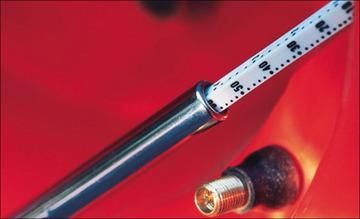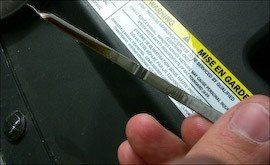The owner’s manual of any car will tell you—in the most excruciatingly simplistic step-by-step manner possible—how to operate everything from the seat-belts to the trunk lock and how to finely tune the rear headrests with ferocious, compulsive precision. And on virtually every page there will be a yellow box screaming at you not to do something stupid like lick the brake discs or serve the radiator water as an after-dinner digestif. After all, based on the advice of their attorneys, manufacturers have to assume that anyone who buys their cars must be a total moron.
Although the average owner’s manual overdoes it, that doesn’t mean we can’t all use an occasional refresher course in automotive common sense. And, don’t take this wrong, but we know there are plenty of you out there who won’t admit to the simple things you flat never learned.
So here is our unabashed (but slightly bashed) guide to the most elementary challenges of automotive operation. This is the stuff you didn’t necessarily learn in drivers’ education and your father just assumed you learned through transgenerational osmosis.
1. How to Change a Tire
It used to be that blowouts were a regular motoring event—right up there with thumping the occasional headlight-mesmerized raccoon and being forced to use a gnarly gas-station restroom. Thankfully, modern tires rarely shed a tread or spontaneously deteriorate. But guaranteed there will come a time when you’ll be forced to change a tire.

If a tire blows, don’t try to save it or its wheel by stopping immediately in a lousy situation; the shoulder of a busy freeway counts as a lousy situation. If possible, find a level, solid, well-lit surface and park, even if that means driving a mile at low speed with your hazard lights on. And for God’s sake, don’t stop in traffic. Ever. Then make sure the car can’t roll. The parking brake should be on, and the transmission in park (in an automatic) or in gear (in a manual).
Grab the spare, lug wrench, and jack. Most newer cars use scissors-type jacks that raise the car up at a predefined point on the car’s structure. All the info on where the tools and jacking points are is in the owner’s manual.
Now, lift the car using the jacking point nearest the disabled wheel so that the weight of the car is on the jack but the tire is still in contact with the road. If there’s a hubcap, that will need to be removed so the lug nuts can be accessed.
With the tire still in contact with the road, the lug nuts should be cracked loose (counterclockwise) but not removed. The car can then be jacked up farther and the lugs removed. With the nuts off, the tire and wheel assembly can be removed.
Put the spare on, and hand-tighten the lug nuts (clockwise). The car can now be lowered so the tire is touching the ground, although the car’s weight should remain on the jack. The lug nuts should then be tightened further using a star pattern (around the wheel, skipping every other lug) to ensure that they snug down evenly on the wheel.
Lower the car all the way onto the ground. Tighten the lug nuts down as snugly as possible. Hit the road.
Alternatively: Call the auto club.
2. How to Jump-Start a Car
First, make sure it’s the battery that’s really the problem. If the car’s lights come on brightly and the starter motor churns with its usual ferocity, the battery is likely heaving out plenty of amps.
Second, make sure you have a good set of jumper cables—robust, rubber-coated cables that can handle the amperage. Virtually all jumper cables should be color-coded with the red clamp intended for the positive pole on the battery and the black clamp for the negative.

JUMPER CABLES
Ideally, the car with the bum battery and the jump car should be parked on a clean, dry surface. And they should be parked so that the cars’ batteries are accessible and close enough to each other that the cables can comfortably span the space between them without being taut.
With both cars off, attach one of the red clamps to the positive (+) terminal on the battery that’s presumed bad. Be careful of the other red clamp—it’s now live. Then connect that other red clamp to the positive terminal on the jump car’s battery. After that, one black clamp goes to the negative (-) terminal on the good battery while the other black clamp should go to an unpainted steel surface on the stalled car, to be grounded.
Start the car with the good battery. Routing the cables this way uses the battery on the live car to start the disabled car, so there is no need to wait for the dead battery to charge. Start the dead car. Remove the cables in reverse order, close the respective hoods, and operate the two cars as usual.
If the electrical system in the car with the drained battery is otherwise okay, the battery should be recharged after about 15 minutes of driving and the whole thing should be okey-dokey.
Alternatively: If the car with the dead battery has a manual transmission, there’s always bump-starting the car, too. With the key turned on, the car in first gear, and the clutch pushed in, get the car rolling forward (by pushing it or by rolling down a conveniently located hill), and once up to jogging speed, quickly release the clutch. The car should jerk, then start.
3. How to Check Your Tire Pressure
Everything any car does depends on the four rubber donuts on which it sits. Making sure those tires are properly inflated is the best way to guarantee your car performs at its best from a handling and fuel-efficiency standpoint.

TIRE PRESSURE GAUGE
There are fancy tire gauges and straightforward tire gauges, but they all work pretty much the same way. Simply take the gauge to each tire, remove the valve-stem cap (and put it in your pocket so you don’t lose it on the ground), press the gauge flat against the valve stem, and the gauge will read the pressure. If you hear air hissing out of the valve alongside the gauge, you don’t have a complete seal and will get an inaccurate reading. What that reading should be is usually listed on a sticker in one of the front doorjambs. Or it’s in the owner’s manual. The proper pressure is not the maximum listed on the tire itself; that’s often far too high.
After that, it’s a matter of adding air and rechecking the pressure until the tires are at their correct inflation. But be careful not to overinflate, because that leaves the car riding on smaller, less stable contact patches.
Remember, it’s best to measure your tire pressure when the tires are cold—after the car has been parked for the night is ideal. Tires that are warm after running all day will have a higher pressure from the additional heat. Tire pressures should be checked at least once a month.
Alternatively: When tires shred, steel wheels make beautiful sparks against the pavement.
4. How to Check Your Oil
The oil in your car’s engine is there to lubricate, not burn. So checking your oil is a way to determine if there’s enough of the stuff aboard and if the engine has developed an appetite for it.
First, look in the owner’s manual and determine where the oil dipstick is. In most cars it’s alongside the engine block and marked with a brightly colored handle and an oil-can icon.
Take your car for a spin to warm the oil to normal operating temperature. Then park the car on a level surface and let it sit with the engine off for at least five or ten minutes. Open the hood, find the dipstick, and pull it out by the handle. The long shaft of metal that makes up the majority of the stick should be covered in engine oil. Wipe that off with a clean rag.

Reinsert the dipstick, and then pull it out again. At the bottom of the stick will be markings showing where the normal oil level should be. If there’s oil on those markings, you’re good. If it’s below them, add a half a quart of oil at a time until you reach the appropriate level. If there’s no oil on the stick at all, you have a problem.
Don’t run your engine on a measly oil supply. Add the appropriate type of motor oil (that’s in the owner’s manual, too) as soon as possible to an engine that’s low. Even if it’s only been a few hundred miles since the oil sump was filled, you could have serious problems.
Alternatively:Throwing a bearing is destructive and dramatic.
5. How to Get Unstuck

First, get out and see how bad you are stuck. If it is just your drive wheels that are blocked, the process will be much simpler. But if you tried to plow through a drift and the whole car is angled on a mound of mud, you’re going to have to do some digging first to get the car back on solid ground.
If you can move at all, “rock” the vehicle back and forth by shifting between drive and reverse and going as far as you can in either direction.
Sometimes it helps to clear a little space around your front tires by cranking the steering wheel back and forth. You can get a little extra traction by putting cardboard under the drive wheels, too. If there’s no cardboard around and the situation is desperate, the car’s floor mats might also work. If that fails, keep shoveling.
From mud or sand: Whatever you do, don’t spin the tires. That will just dig a deeper hole. Instead, put something in the intended path of the drive wheels—palm fronds, branches, beach towels, wood blocks, your kid brother, anything—and proceed slowly.
Ideally, if you’re wandering off-road, you should bring a mud ladder or sand ladder with you. Mud and sand ladders are basically small bridges made of steel, rope, or wood that can be placed before the drive wheels and driven across. Of course, anyone so well prepared as to have a sand or mud ladder along is also more likely to have a buddy with a winch nearby.
Alternatively:Abandon the vehicle in place and buy a new one.
SOURCE: John pearley Huffman/car and driver
